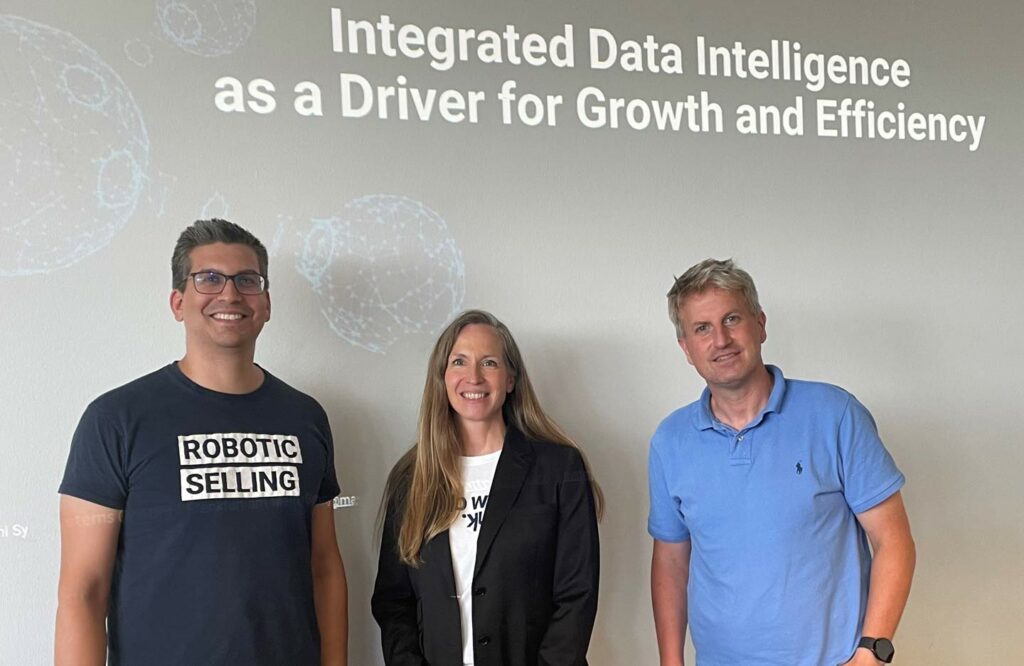Björn Gerster, Director Marketing Consulting DACH at Dun & Bradstreet Europe, in an interview with Norbert Schuster about digital transformation in companies and what that actually means. Björn also explains how important automated data enrichment is for digital transformation in marketing and sales.
Norbert Schuster: Björn, before we talk about data enrichment, I would like to ask you a general question about digital transformation in marketing and sales: How important is digital transformation in marketing and sales?
Björn Gerster: We should first explain what we actually mean by digital transformation.
Technological change is so great that it is having a significant impact on the way we do business – and at an increasing pace. Almost all current change processes are accompanied by the emergence and processing of new types of data – driven by new and increasingly powerful methods. AI (artificial intelligence) and real-time are certainly the elements to highlight here. We need to manage and use data much more efficiently and effectively across the enterprise, across all business units, across all touchpoints, to remain competitive. Analog and manual processes must be digitized.
In this context, the central goal of Digital Transformation is to increase efficiency by automating decisions and processes (Campana & Schott: Future IT Report 2020). It is about putting puzzle pieces together, recognizing patterns on a completely different level than the human brain can.
Efficiency has two facets here – on the one hand, cost efficiency by replacing error-prone and time-consuming manual processes, and on the other hand, sales efficiency by being able to focus on those qualified opportunities and leads with the greatest value and highest probability of closing.
For Marketing & Sales, digital transformation is the only chance to meet customer demands. Customers expect a consistently attractive customer experience – regardless of the channel through which they interact with us.
That’s why, in my view, it’s always about the triad of
- Data, in order to generate relevant messages from firmographic and usage- or interest-driven information,
- Connectivity of touchpoints and systems, in order to be able to let the generated information flow in the sense of a 360-degree customer view, and
- Rule-based or AI-driven automation of processes.
It is clear that digitization is always both a challenge and an opportunity. On the one hand, it puts pressure on companies that do not have the necessary structures to adapt quickly and flexibly to market changes. On the other hand, it holds growth potential for those companies that consistently implement their digital transformation. We see in many projects that this succeeds particularly well when companies approach it holistically.
Digital transformation is a corporate strategy task. It is essential to anchor responsibility for this at the highest management level and to entrust a board of management with the task of managing the digital transformation across all departments. The appointment of a Chief Digital Officer (CDO) sends a signal to executives and employees that corporate management gives high priority to digital transformation.
Norbert Schuster: Where do you see the biggest challenges for marketing and sales? What should readers definitely pay attention to?
Björn Gerster: The central questions essentially revolve around 3 areas:
- How do I find the right leads?
- How do I become relevant to my target group?
- How do I ensure the efficiency and effectiveness of my measures?
And the answers to all 3 questions can be found in digital transformation.
What do I mean by that? Quite simple…
- I can only find the right leads if I understand what value my customers get from my products & services. Finding the value means making the best use of the existing data of my customers. I need to break down the existing silos, merge the data and eliminate duplicates. The basis for this is valid, complete and up-to-date data… we will certainly come to that later again.
- I become relevant when I address my potential customers with the right topics at the right time. To do this, I should link my internal data with external data and analytical models in real time to identify those leads with the highest likelihood of purchase. There are many exciting approaches to this in B2B marketing. GDPR must be taken into account, of course.
- I can best ensure efficiency by automating processes and, in turn, ensuring that the data underlying the processes is correct, complete, and up-to-date!
For many companies, this means a comprehensive transformation to a holistic data and information structure across all areas, regardless of the target group B2B or B2C.
The fact, that there is not much time left for this, was impressively shown to us by 2020 for Marketing and Sales. It has once again become very clear that the dialog with prospects and customers must be placed on a digital footing in order to be able to systematically send out impulses in the new world of communication.
Norbert Schuster: What is the importance of master data management and data enrichment for digital transformation in marketing and sales?
Björn Gerster: The digitization of business processes generates an incredible wealth of data. We have to learn how to use it optimally in order to achieve growth targets in the end.
An important prerequisite for this is to know which information is correct and which is relevant. With the multitude of information systems in use – from CRM to marketing automation platforms to payment and credit systems – data quickly becomes inconsistent.
Salesforce reveals in a recent study that 91% of data in CRM systems is incomplete and approximately 70% of data becomes outdated every year.
The lack of a holistic view of customer relationships still hampers the customer experience far too often. Customers and leads are addressed at the wrong time with the wrong topics, deliveries go to the wrong delivery addresses, and sales invests far too much time on the wrong potentials.
In short, unreliable data leads to missed growth opportunities.
Creating a single, unified version of every customer and prospect relationship across multiple channels requires clean, complete and consistent data. To ensure this, many companies are taking the approach of matching their own data against a so-called “Reference Data Universe” and using this datacloud to tag their own data with a unique identifier, standardize it, complete it, and enrich it with further information where necessary. Integration via APIs with associated monitoring processes can ensure up-to-dateness.
There are exciting possibilities to enrich not only classic firmographic information, but also online generated information about positioning on the website, technologies used, current events and press releases or even third party intent data from the area of search behavior on the web, to name just a few examples. All this data can be used to derive current needs and, above all, relevant addresses. Imagine you offer IT services and integration services for ERP systems. In addition to the classic segmentation via industries, company size, etc., you now know via third-party intent data which companies are increasingly informing themselves on the web about selected ERP systems, which companies are currently advertising positions for project management in the ERP area, which companies are talking about modernizations in the ERP area in articles or press releases, and for which companies certain keywords on the website allow conclusions to be drawn. Advantages for your sales department!
Companies with modern and successful sales and marketing strategies manage their data strategically and turn data into insights and knowledge to achieve their own growth targets.
Is the effort worth it? Yes, definitely! It is now standard practice for us to calculate business cases with our customers and to conduct an ROI analysis. But the following statements also prove it:
- Data-driven companies are 23 times more likely to win new customers (McKinsey “Global Insights”).
- The average growth of insight-driven companies is around 30% (Forrester – “The insight-driven-business”).
Norbert Schuster: In conclusion, Björn. What questions should a company that is in the process of transforming to a data-driven business deal with?
Björn Gerster:
First of all, it must be clear that master data management organization is both the foundation and a journey. I see companies stumble again and again when they try to introduce Master Data Management company-wide as part of a “big bang approach”. Not because they don’t have the technical means to do so, but because employees, departments and national companies cannot be convinced of the added value, or there is a lack of internal resources or knowledge, or top management is ultimately not backing it. Master data management and thus also data governance must be rooted in the corporate strategy. Roles and responsibilities must be clarified and a change management process initiated. The basis and usually the first use case is the master data for customers and prospects with the corresponding onboarding and update processes, which are ensured via interfaces. Subsequently, further use cases are added, in particular from the areas of risk management and compliance. These are areas that also benefit from structured and up-to-date master data and which naturally have additional requirements.
A useful starting point is always a status analysis of the existing data quality. I often see that customers cannot give us a clear answer as to how many customers and prospects they have in total in their systems. A status analysis helps to obtain a dedicated view of one’s own data. By enriching a unique identifier (the D-U-N-S® number), we create an important prerequisite for creating a golden record in the customer systems. At the same time, the status analysis shows further exciting insights, such as the economic activity of the business partners, distributions across different industry classifications (e.g. SIC, NAICS or WZ), turnover classes or the share of companies linked in group trees as well as the role the company plays in the group tree.
The central questions that then need to be answered are at what point can manual processes be automated, which data is required for which use case in which system and process, which of these are available internally or should be enriched externally? Of course, these questions must be discussed not only from a business perspective, but also from a technical and process perspective. What framework conditions exist in the company’s own IT infrastructure, are direct integrations into existing systems desired, or is the use of connectors or iPaaS solutions (Integration Platform as a Service) a possibility?
Regardless of where a company stands, we look forward to an exchange!
Norbert Schuster: Thank you very much for the interview, Björn!



